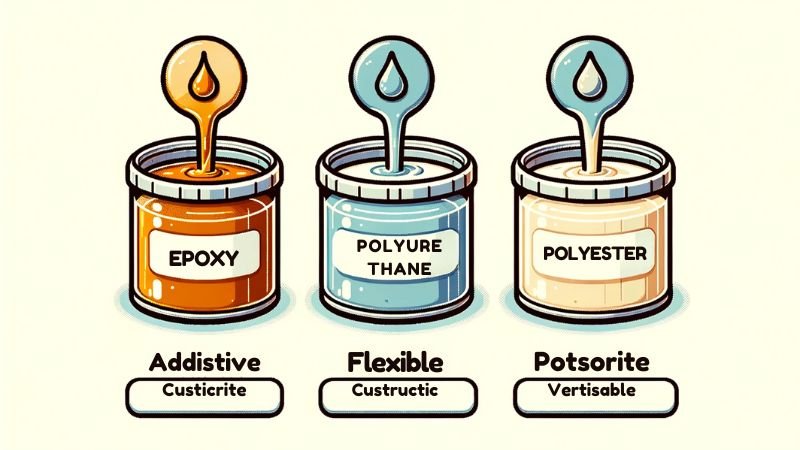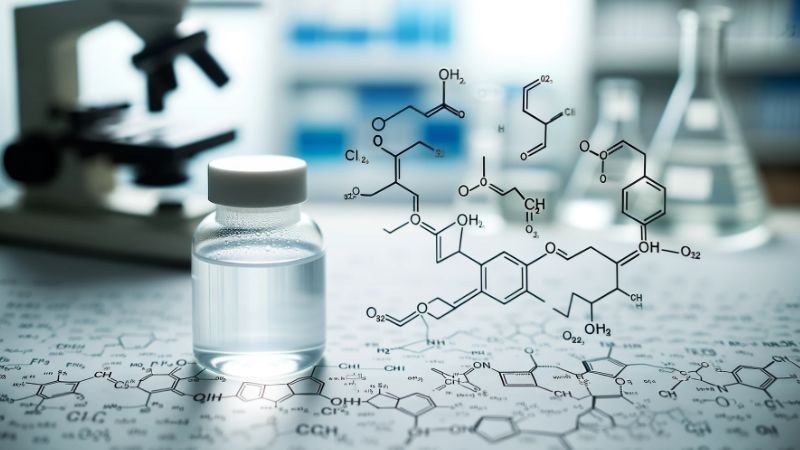Polyester resin stands as a cornerstone in the realm of polymers, renowned for its versatility and widespread applications.
What is Polyester Resin?
Polyester resin, at its core, is a polymer – a chain of repeating molecular units. But what makes it stand out in the crowded world of polymers?
Definition and Basic Chemistry
Polyester resins are unsaturated synthetic resins formed by the reaction of dibasic organic acids and polyhydric alcohols. These are typically viscous, pale-colored liquids. Their chemistry is fascinating, involving a dance of molecules where acids and alcohols come together to form ester links.

Comparison with Other Resins
While there are myriad resins available, each with its unique properties, polyester resin claims its own space due to its distinct characteristics. For instance:
- Epoxy Resin: Known for its superior adhesive properties and resistance to chemicals. However, it’s typically more expensive than polyester.
- Polyurethane Resin: Offers flexibility and is used in applications where high abrasion resistance is essential. Yet, its sensitivity to moisture during curing can be a limitation.
In contrast, polyester resin is often favored for its cost-effectiveness, ease of use, and adaptability to various applications.
Types of Polyester Resins
Not all polyester resins are created equal. Depending on their chemical backbone, we classify them into several types, each with unique attributes tailored for specific applications.
Orthophthalic Resin (General-Purpose Resin)
Originating from phthalic anhydride, this is the most common type of polyester resin in the market. It’s your jack-of-all-trades – reasonably priced and versatile.
Properties:
- Good mechanical properties
- Adequate resistance to water and various chemicals
Typical Applications:
- Used in the production of fiberglass laminates, such as those found in bathtubs, boats, and small automotive parts.
Isophthalic Resin
Deriving its name from isophthalic acid, this resin provides an enhanced performance over its orthophthalic sibling.
Properties:
- Superior water resistance
- Enhanced corrosion resistance against a range of chemicals
Typical Applications:
- Ideal for marine environments, such as boat hulls that need to withstand constant water exposure.
- Used in industrial applications where chemical resistance is a priority.
Dicyclopentadiene (DCPD) Resin
DCPD is a byproduct of naphtha cracking. When incorporated into polyester resin, it offers some intriguing benefits.
Properties:
- Low shrinkage
- Improved toughness and flexibility
Typical Applications:
- Automotive parts, where a smooth finish and high impact resistance are paramount.
- Body panels of vehicles due to its high-quality surface finish capability.

Properties of Polyester Resin
To truly appreciate the versatility of polyester resin, one must dive into its intrinsic properties. These characteristics not only set it apart but also determine its suitability for various applications.
Mechanical Properties
- Strength: Polyester resins exhibit commendable tensile, flexural, and compressive strength, making them ideal for structural applications.
- Flexibility: While not the most flexible of resins, they offer enough give to prevent brittleness in most of their applications.
- Hardness: Upon curing, polyester resins form a hard surface, which can be further reinforced with additives and fibers.
Chemical Resistance
- General: Polyester resins, especially isophthalic variants, resist a wide spectrum of chemicals, from weak acids to bases.
- Water Resistance: One of the reasons for their popularity in marine applications, polyester resins showcase good water resistance, especially when formulated correctly.
Durability and Lifespan
- UV Stability: While inherently not the most UV stable, polyester resins can be modified with additives to withstand prolonged sun exposure.
- Wear and Tear: Given their mechanical strength, polyester resins endure the rigors of daily use, resulting in long-lasting products.
Ease of Use and Versatility
- Curing: Polyester resins can be cured at room temperature, using catalysts like MEKP (Methyl Ethyl Ketone Peroxide).
- Adhesion: They adhere well to a variety of surfaces, eliminating the need for extensive surface preparations.
- Versatility: Their ability to be combined with fillers, pigments, and other additives makes them adaptable to a plethora of applications.

Key Applications
Polyester resin’s multifaceted properties render it indispensable across diverse industries. From marine vessels cruising the oceans to the very cars we drive, its presence is ubiquitous.
Marine Industry
- Boat Hulls: Thanks to its water and chemical resistance, polyester resin is the primary choice for crafting boat hulls, ensuring they remain impervious to the constant aquatic onslaught.
- Decking & Components: Beyond the hull, other boat parts like decks, masts, and interiors often employ polyester resin due to its durability and ease of maintenance.
Automotive
- Body Fillers: Ever wondered about the putty-like substance used to smooth out dents in vehicles? That’s often a mix of polyester resin and fillers, prized for its ease of application and sanding.
- Laminates & Panels: The shiny, sleek exterior of many cars owes its luster to layers of polyester resin-infused fiberglass.
Construction
- Panels & Cladding: Buildings, especially commercial ones, might use polyester resin-based panels for both aesthetics and durability.
- Bathroom Fixtures: The sturdy yet stylish bathtubs, sinks, and shower stalls, often made of fiberglass, rely on polyester resin for their form and function.
Arts & Crafts
- Sculptures & Figurines: Artists often turn to polyester resin when crafting sculptures, appreciating its moldability and finish.
- Jewelry: The resin jewelry trend sees artisans embedding objects and pigments into transparent polyester resin, creating captivating pieces.
Advantages and Disadvantages
Like any material, polyester resin brings to the table a blend of benefits and limitations. Recognizing these can guide informed decision-making in its application.
Advantages
- Cost-Effectiveness: One of the primary reasons for its widespread use, polyester resin offers a good balance of performance at an affordable price point.
- Ease of Use: With its ability to cure at room temperature and straightforward mixing procedures, it’s user-friendly, especially for beginners.
- Adaptability: Polyester resin’s compatibility with various additives, fillers, and fibers allows it to cater to a multitude of application-specific requirements.
- Durability: Its inherent strength and resistance to many environmental factors mean products made with polyester resin tend to have a long life.
- Good Adhesion: Its ability to bond well with many surfaces negates the need for complex surface preparations.
Disadvantages
- Brittleness: In comparison to some other resins, especially when not reinforced, polyester can be more prone to cracking under stress.
- UV Sensitivity: Prolonged exposure to sunlight can degrade polyester resin unless it’s modified with UV stabilizers.
- Lower Heat Resistance: Relative to materials like epoxy, polyester resin has a lower threshold for withstanding heat.
- Shrinkage: During the curing process, polyester resin can exhibit some shrinkage, which might be a concern in precision applications.
- Odor: The characteristic smell during the curing process might be off-putting to some, especially in confined spaces.

Environmental Impact and Sustainability
In an era increasingly defined by environmental consciousness, understanding the ecological footprint of materials we use daily is paramount. Polyester resin, while instrumental in many industries, carries environmental considerations that demand attention.
Environmental Concerns
- Non-Biodegradability: Like many synthetic polymers, polyester resins do not easily degrade in the environment. This results in long-lasting waste, especially when products reach the end of their lifespan.
- Manufacturing Emissions: The production of polyester resin involves chemical processes that can release pollutants into the air and water.
- Volatile Organic Compounds (VOCs): During the curing process, some formulations of polyester resin can release VOCs, which contribute to air pollution and can be harmful in confined spaces.
Steps Towards Sustainability
- Recycling Initiatives: Efforts are underway to recycle products made from polyester resin, ensuring they don’t end up in landfills. While challenges exist, advancements in technology offer promise.
- Bio-Based Resins: Researchers are exploring resins derived from renewable resources as alternatives to traditional petroleum-based polyester resins.
- Reducing VOC Emissions: Modern formulations and additives aim to minimize the release of VOCs during the curing process, mitigating environmental and health concerns.
- Responsible Manufacturing: Companies are implementing cleaner production methods, reducing emissions, and focusing on sustainable sourcing of raw materials.
Future Trends
As we navigate through a rapidly evolving world, polyester resin is poised to journey alongside, adapting and innovating. Here’s a glimpse of what the horizon holds for this versatile material.
Technological Advancements
- Nanotechnology: Incorporating nano-fillers into polyester resin can drastically enhance its properties, from mechanical strength to UV resistance.
- Smart Materials: Imagine a boat hull that self-heals minor scratches or automotive panels that change color with temperature. The integration of polyester resin with smart additives can make this a reality.
Environmental Focus
- Green Polyester: The push towards eco-friendly alternatives will lead to more widespread adoption of bio-based polyester resins, decreasing dependency on fossil fuels.
- Circular Economy: Efforts will intensify to create a closed-loop system for polyester resin products, promoting reuse and recycling over disposal.
Broader Application Scope
- Medical: With biocompatibility advancements, we might see polyester resins in medical applications, from prosthetics to medical equipment housing.
- Space and Aviation: As research progresses, polyester resin composites might find applications in the demanding realms of aerospace and space exploration.
Collaborative Research
- Industry-Academia Partnerships: Collaborations between industries and academic institutions will accelerate research, driving forward innovations in polyester resin applications and formulations.
Conclusion
Polyester resin, a material that has seamlessly woven itself into the fabric of diverse industries, stands as a testament to human ingenuity and adaptability. From its foundational chemistry to its expansive applications, its story is one of versatility and evolution.
While it’s not without its challenges, especially in the realm of environmental sustainability, the future appears bright. With technological advancements on the horizon, combined with a heightened emphasis on eco-conscious practices, polyester resin is set to evolve in ways that further its utility while aligning with global sustainability goals.





